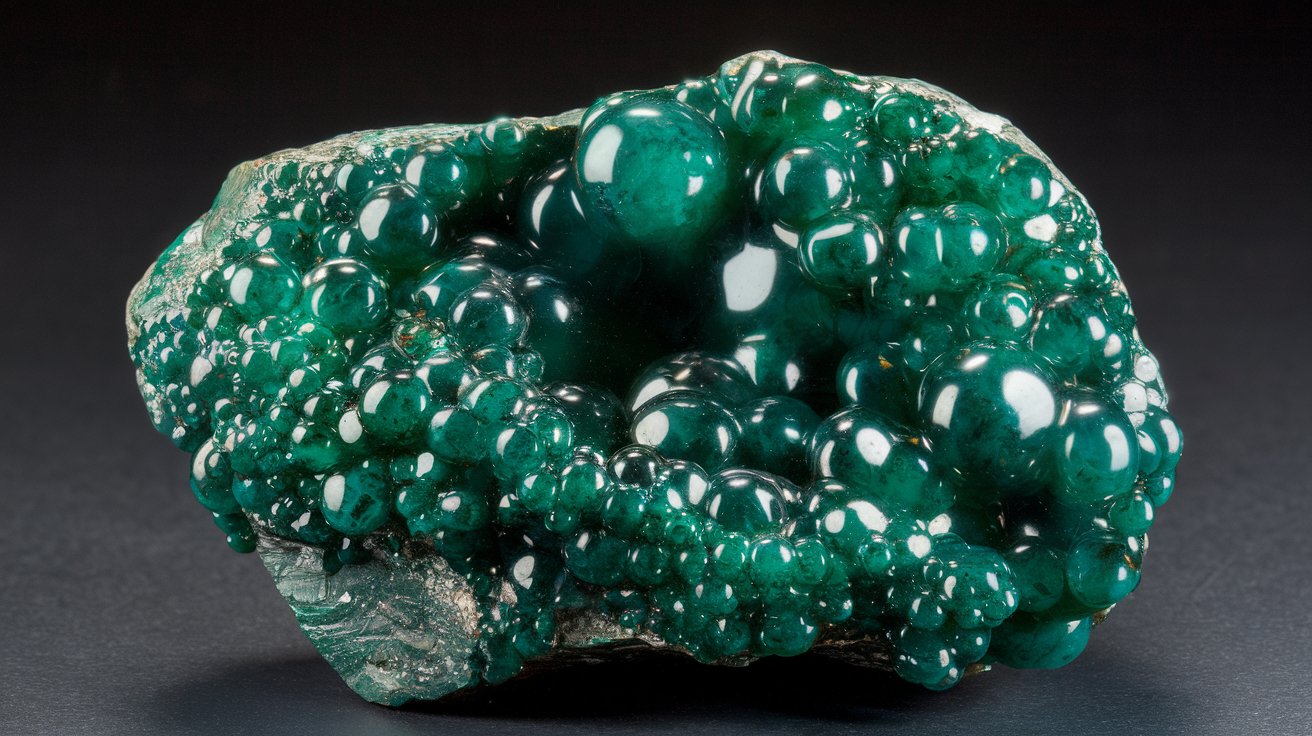
Arthurite, a rare and captivating mineral, has intrigued geologists and collectors alike. But what exactly makes Arthurite so special? Found in only a handful of locations worldwide, this mineral boasts a unique green hue and intricate crystal structure. Named after Arthur Russell, a notable British mineralogist, Arthurite's discovery dates back to the early 20th century. Its chemical composition includes elements like copper, iron, and arsenic, which contribute to its distinct appearance. Why should you care about Arthurite? Whether you're a budding geologist or a seasoned collector, understanding Arthurite's properties and history can deepen your appreciation for Earth's hidden treasures. Ready to dive into 35 fascinating facts about this extraordinary mineral? Let's get started!
Key Takeaways:
- Arthurite is a rare, vibrant green mineral named after a British mineralogist. It's prized by collectors and can fluoresce under UV light, making it a fascinating subject for study and photography.
- Found in specific locations like Cornwall, Arthurite's scarcity adds to its allure. Its softness requires gentle care, and it can be used as an indicator of arsenic-rich environments.
Arthurite: A Rare Mineral
Arthurite is a fascinating and rare mineral that captures the interest of geologists and mineral enthusiasts alike. Its unique properties and history make it a subject worth exploring. Here are some intriguing facts about Arthurite.
-
Arthurite is a rare phosphate mineral that was first discovered in 1954. It is named after Arthur Russell, a prominent British mineralogist.
-
The mineral typically forms in oxidized zones of arsenic-rich ore deposits. These environments provide the perfect conditions for Arthurite to develop.
-
Arthurite crystals are usually small and can be found in various shapes, including prismatic and acicular forms. Their size often makes them difficult to spot without a microscope.
-
The color of Arthurite ranges from green to blue-green. This vibrant hue is due to the presence of copper in its chemical composition.
-
Arthurite has a vitreous to silky luster, giving it a shiny appearance that can make it stand out among other minerals.
Chemical Composition and Structure
Understanding the chemical makeup and structure of Arthurite can provide deeper insights into its formation and properties.
-
The chemical formula for Arthurite is CuFe2(AsO4)2(OH)2·4H2O. This complex formula indicates the presence of copper, iron, arsenic, oxygen, and hydrogen.
-
Arthurite belongs to the monoclinic crystal system. This means its crystals have three unequal axes, with one of them being inclined.
-
The mineral has a Mohs hardness of 3.5 to 4. This makes it relatively soft compared to other minerals, which can affect how it is handled and studied.
-
Arthurite's specific gravity ranges from 3.1 to 3.3. Specific gravity is a measure of density, and this range indicates that Arthurite is denser than many common minerals.
-
The mineral is often associated with other secondary minerals such as scorodite, pharmacosiderite, and olivenite. These associations can provide clues about the geological history of the area where Arthurite is found.
Occurrence and Locations
Arthurite's rarity means it is not found everywhere. However, there are specific locations where this mineral is more commonly discovered.
-
Arthurite was first discovered in Cornwall, England. This region is known for its rich mineral deposits and has been a significant site for mineralogical studies.
-
The mineral has also been found in other parts of the world, including the United States, Germany, and Australia. Each location provides unique samples that contribute to our understanding of Arthurite.
-
In the United States, Arthurite has been discovered in Utah and Nevada. These states have diverse geological features that create ideal conditions for the formation of rare minerals.
-
German specimens of Arthurite are often found in the Harz Mountains. This area is known for its complex geology and rich mineral diversity.
-
Australian Arthurite is typically found in the Broken Hill region. This location is famous for its extensive ore deposits and has produced some of the finest mineral specimens in the world.
Uses and Significance
While Arthurite may not have widespread industrial applications, it holds significant value in other areas.
-
Arthurite is primarily of interest to mineral collectors. Its rarity and unique properties make it a prized addition to any collection.
-
The mineral is also studied by geologists and mineralogists. Understanding Arthurite can provide insights into the geological processes that create rare minerals.
-
Arthurite's vibrant color makes it a popular subject for photography. High-quality images of Arthurite crystals can be both scientifically valuable and visually stunning.
-
The mineral can sometimes be used as an indicator of arsenic-rich environments. This can be useful in environmental studies and mining operations.
-
Arthurite specimens are often displayed in museums. These exhibits help educate the public about rare minerals and the natural world.
Interesting Tidbits
Beyond its scientific and practical significance, Arthurite has some fascinating aspects that add to its allure.
-
Arthurite can fluoresce under ultraviolet light. This property makes it an exciting subject for mineral enthusiasts who enjoy exploring minerals' hidden characteristics.
-
The mineral's name honors Arthur Russell, who made significant contributions to the field of mineralogy. Naming minerals after prominent scientists is a common practice that acknowledges their work.
-
Arthurite is often found in small quantities. This scarcity adds to its value and makes each discovery noteworthy.
-
The mineral's formation involves complex chemical reactions. These reactions occur over long periods, often requiring specific environmental conditions.
-
Arthurite can sometimes be confused with other green minerals. Careful analysis and identification are necessary to distinguish it from similar-looking minerals.
Preservation and Care
Given its rarity and softness, Arthurite requires special care to preserve its beauty and integrity.
-
Arthurite should be stored in a stable environment. Fluctuations in temperature and humidity can damage the mineral.
-
Handling Arthurite with care is essential. Its softness means it can be easily scratched or damaged.
-
Cleaning Arthurite should be done gently. Using mild soap and water is recommended, avoiding harsh chemicals that could harm the mineral.
-
Displaying Arthurite in a protective case can help prevent damage. This also allows for better viewing and appreciation of its unique properties.
-
Regularly inspecting Arthurite specimens can help identify any signs of deterioration. Early detection can prevent further damage and preserve the mineral's condition.
Fun Facts
To wrap up, here are some fun and lesser-known facts about Arthurite that highlight its unique characteristics.
-
Arthurite's vibrant color can change depending on the lighting. This makes it an intriguing subject for study and photography.
-
The mineral's name is sometimes misspelled as "Arthurite" instead of "Arthurite." Attention to detail is crucial in mineralogy.
-
Arthurite has inspired artists and jewelers. Its striking appearance can serve as inspiration for various creative projects.
-
The mineral's discovery in Cornwall has contributed to the region's reputation as a hotspot for rare minerals.
-
Arthurite's unique properties continue to fascinate scientists. Ongoing research aims to uncover more about this rare and beautiful mineral.
Final Thoughts on Arthurite
Arthurite, a rare copper arsenate mineral, holds a unique place in the world of geology. Its vibrant green color and intricate crystal structure make it a favorite among collectors and mineral enthusiasts. Found primarily in Cornwall, England, this mineral is not just a pretty face; it tells a story of the Earth's geological processes. Arthurite forms in the oxidation zones of copper deposits, often alongside other minerals like olivenite and scorodite. Its discovery in the early 20th century added a new chapter to mineralogy, providing insights into the complex interactions between copper and arsenic. Whether you're a seasoned geologist or just someone who loves learning about the natural world, Arthurite offers a fascinating glimpse into the Earth's hidden treasures. So next time you come across this striking mineral, you'll know a bit more about its rich history and significance.
Frequently Asked Questions
Was this page helpful?
Our commitment to delivering trustworthy and engaging content is at the heart of what we do. Each fact on our site is contributed by real users like you, bringing a wealth of diverse insights and information. To ensure the highest standards of accuracy and reliability, our dedicated editors meticulously review each submission. This process guarantees that the facts we share are not only fascinating but also credible. Trust in our commitment to quality and authenticity as you explore and learn with us.


